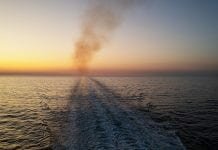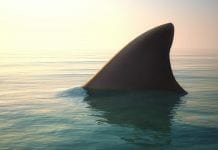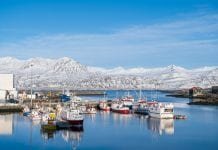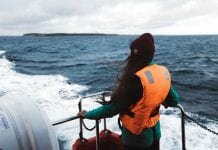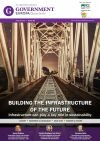
Government Europa explores the advance of maritime transport technology, which is feeding into manufacturing for shipping.
Like the autonomous vehicles of the present, vessels and maritime transport could soon see more and more advances in artificial intelligence (AI) and autonomous technologies. Currently, ships have such features as automatic navigation systems, though these are expected to develop into automated control.
A joint report by global technical and business service Lloyd’s Register (LR), British multinational defence technology company QinetiQ, and the University of Southampton, UK, predicts that unmanned surface and underwater vessels are likely to dominate the maritime transport industry over the coming decade.
Speaking to Ship Technology in a follow-up to the Global Marine Technology Trends 2030 review – a collaborative project between the three organisations – LR Marine and Offshore technical director Tim Kent said: “Networks of autonomous surface and underwater vessels are set to radically change the nature of maritime operations … These developments, enabled by technology, provide new opportunities and potential for disruptive business models.”
Assessing a need
By using such technology, on-board space could potentially increase – for extra cargo or passengers, for example – and ship exteriors could be streamlined. Furthermore, ships currently carry excess weight in the heavy ballast they require. By removing the superstructure and redistributing the weight, the amount of ballast required could be significantly reduced, which would add further benefits for the ecosystems of marine life often disrupted by the transfer of ballast water.
ScienceDaily reports that, despite this, autonomous vessels for maritime transport require external on-demand monitoring and control by professionals based on land. Oskar Levander, vice-president of innovation at Rolls Royce Marine, spoke to Smithsonian about the efficiency of autonomous vessels: “We are not constrained by the same limitations that a manned vessel has … A ship on the open sea … will be controlled by an on-board computer, with the occasional oversight of a land-based operator who may manage hundreds of different ships at once.”
Therefore, human factors will still need to be considered in the design of autonomous vessels. With this in mind, the Fraunhofer Centre for Marine Logistics and Services, Germany, is assessing the technological and legal aspects of autonomous ships. As most maritime accidents are caused by operator fatigue, the Maritime Unmanned Navigation through Intelligence and Networks (MUNIN) report – led by The Fraunhofer Centre – outlined how it anticipates a tenfold decrease in the risk of foundering and collision as a result of ongoing autonomy.
Despite these expectations, regulatory bodies will still require evidence to support such suggestions. Kent added: “The principal challenges will be the integration of these autonomous systems into current maritime operations, legal and regulatory requirements and, not least, the impact upon seafarers.”
Despite the considerations that need to be made and assessed, the benefits remain worthwhile. Levander added: “It’s really only when you go fully unmanned that you can reduce all the systems. When we add this all together, the reduced electrical consumption when we take out systems, the lower weight of the vessel, the lower wind resistance, we talk about a 10-15% fuel saving.”
Design for development
The VTT Technical Research Centre of Finland has in-depth knowledge of reliability and safety concerns with regards to autonomous ship research. Moreover, VTT has made efforts to study the interplay between people and the technologies they operate, and from such has developed a concept for bridges and the shore control centres that will operate the vessels of the future. The research centre’s aims are to enhance the safety and efficiency of operations, as well as providing increased comfort.
Currently developing a safe-steering feature for the remotely monitored and controlled ships of the near feature, VTT’s new technological applications are intended for installation in navigation systems and ship autopilots, steering ships automatically. Apilot, for example, has three modes – track, heading and slow joystick control – ensuring that ships can remain in control in varying circumstances.
Saildrone operates a fleet of unmanned surface vessels (USV) that gather data autonomously and cost-effectively, despite adverse sea or weather conditions. The computer within the drone has the capability to transmit 2,000 parameters in real time via satellites and through various sensors. Collecting measurements such as temperature and humidity, the physical state of the vehicle is logged – including its central processing unit (CPU) – as are its battery status and navigational factors such as wind speed and angle.
A space for ships
Off the coast of Horten, a south-eastern town on the Oslofjord, Norway, space has been made available for Norwegian and international organisations to test new technologies, including vessels, in a convenient, safe and non-congested area. The area has also been specifically designed to enable autonomous vessel trials to take place on behalf of the Norwegian Maritime Authority (NMA) and the Norwegian Coastal Administration (NCA).
The Norwegian technology enterprise Kongsberg Maritime (KM) has been working alongside:
- The town of Horten, Norway;
- Oslo-based registrar and classification society DNV GL;
- The Norwegian Defence Research Establishment (FFI); and
- The University College of South East Norway, in order to launch the test bed.
As reported in Bunkerspot, KM president Egil Haugsdal said: “With critical developments in maritime autonomy technology and software taking place at Kongsberg Maritime in Horten, the location of the new test bed will support a number of groundbreaking technology projects. The move towards greater autonomy at sea has the potential to transform maritime operations and, while the technology has now been proven, we look towards the regulations.
“Establishment of these test beds are an important step, as it shows close co-operation between the people making the technology and vessels and the organisations developing the rules that will allow them to operate.”
The three test beds located in Trondheim and Horten are integral to KM’s current developments. For example, the Yara Birkeland is an all-electric autonomous container ship, whilst the Hrönn, an autonomous offshore support vessel, uses marine robotics technology.
A consortium approach
In December 2017, a consortium of around 20 maritime businesses, as well as knowledge and educational institutions, was established in the Netherlands, also made up of service providers and governments, in order to both study and demonstrate the technical potential of autonomous maritime transport. The group will operate under the Smart Shipping Challenge 2017 framework and, as reported in Ship Technology, the trade association Netherlands Maritime Technology (NMT), which represents the maritime technology sector within the Netherlands, said that the consortium will engage in a joint industry project (JIP) anticipated to reduce operating costs, as well as improve safety and sustainability in shipping.
In that same report, Marnix Krikke, innovation director for NMT, said: “The Delft University of Technology, MARIN and the Netherlands Organisation for Applied Scientific Research (TNO) are all contributing their particular expertise to this applied research for autonomous vessels. This is done in co-operation with industrial partners, the Dutch Ministry of Infrastructure and Water Management, the Dutch Ministry of Defence, the Dutch pilot sector, and the educational institutes Maritime Institute Willem Barentsz, the Shipping and Transport College and Rotterdam Mainport Institute.”
Throughout the two-year applied research project, members aim to establish approaches to applying existing technical solutions to autonomous shipping and maritime transport vessels. Moreover, it also intends to evaluate the requirements for safe navigation in shipping environments, as autonomous vessels are required to make accurate decisions, despite malfunctions or congestion. In order to counteract such circumstances, the consortium will also seek to establish the potential of existing technology to mitigate or resolve such complications onshore, furthering the development of smart shipping. The solutions are to be tested through simulation and in real-world environment methods.
Vessels for the Future
Launched in 2014, Vessels for the Future (VftF) is a maritime research organisation which consists of stakeholders from the sector, all with a shared interest in developing advanced vessel technology for maritime transport, and in ensuring that the maritime industry remains competitive in terms of the global market. The association intends to ensure that:
- Shipping becomes ‘safer, cleaner and more efficient’; and
- Adheres to EU priorities, such as Blue Growth and Transport Modal Shift in relation to research.
The membership association is governed by members through a general assembly. Financed through both public and private means, Vessels for the Future is conducting research across several key areas of the maritime industry as a not-for-profit organisation. Under new vessels and system concepts, it aims to explore how challenging environments can be successfully navigated using ‘Arctic operation vessels for activities at far or deep seas, specialist maintenance and support vessels, [and] research and survey vessels’. In efforts to advance from traditional vessels, the association will assess the need for multi-purpose platforms and specific tools to subsequently harness economic opportunity.
Similar to the test bed facilities in Norway, VftF also anticipates that RDI projects which are capable of powerful simulation and computation will be used to develop and test physical, or virtual, prototypes throughout the construction and lifespan of a vessel. The so-called ‘Pan European Vessel’ demonstrator is to deliver virtual products, virtual lifecycle assessment – including engineering and testing facilities – and operational deployment. Furthermore, simulation will also help in assessing the cost benefits of individual projects.
VftF sees e-Maritime and e-Navigation as integral to the achievement of a safer, more secure, environmentally friendly and competitive maritime industry. The technology and services under these initiatives will enable ship automation, VftF add, that will ‘advance e-Navigation and e-Maritime technologies towards 2020, research will look at how these technologies can be expanded across all aspects of ship operation, including:
- intelligent ships with automated processes;
- smart real-time maintenance and condition monitoring systems;
- advanced navigation systems;
- smart sensors for piracy avoidance; and
- actuator networks.
Real-time monitoring and data collection on the environmental performance of vessels, as well as integration with SafeSeaNet traffic monitoring and information system, will also enhance maritime transport safety and security whilst protecting the marine environment from maritime pollution.
Vessels for the Future has established a series of goals to be met by 2050, including safer maritime transport, cleaner, more efficient transport, and a competitive industry which creates new jobs. The association hopes to ensure that ships are as safe as land-based equivalents, with a risk reduction of 90%, as well as promoting an 80% reduction in CO2 emissions, a 100% reduction of NOx and SOx, and an underwater noise level reduction of 10dB. Meanwhile, in promoting industry growth, VftF hopes to both improve technology supplier productivity and reduce the cost of ship operation by 80%.


